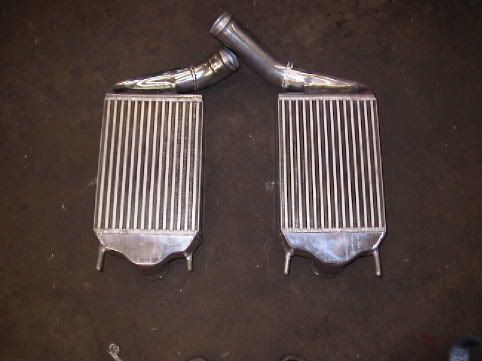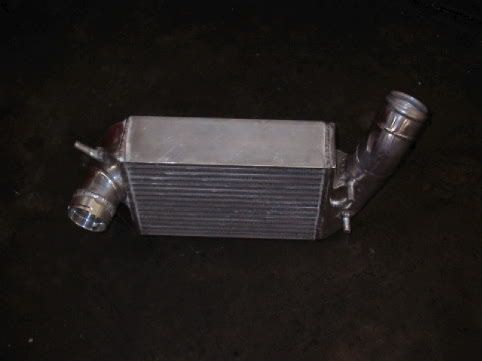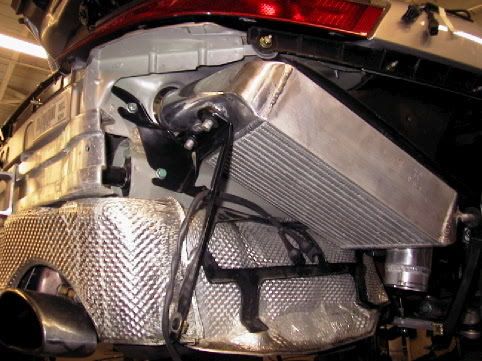What is the difference b/t Agency Power IC, and other much more expensive ones?
#31
Current mods, FVD flash, dv, BMC...plans are IC, turbos, and intake mods. I like the new numbers from Boost Bilet K16's, looking for 600+ flyhwheel hp. I have a track car but once all mods completed the TT will see the track as well...VIR, Glen, Summit, NJMP...I know you get what you pay for, but in the aftermarket world, sometimes you pay too much for what you get. Thanks for the input.
#32
Sean,I understand and appreciate your Protomotive loyalty but make no mistake that there is nothing that Evoms is copying from Proto or anyone else for that matter.Every key component(crank,cams,heads,pistons,studs) that goes into making a car like mine fast has been concieved solely by Evoms.Their tuning philosophy is totally different also from what I can tell and always has been.There is certainly nothing wrong with the way Todd K tunes,they just tune differently and this can be seen if you look closely at the dyno plots of the two tuners. :-)
#33
I agree they they are in their own class when it comes to building motors, Joe. However Todd K was the first to implement the fuel system everyone uses now (dual pumps, etc....EVO was using one big aeromotive back then), the MAF solution/blow through intake, oversize IC's, boost controller, etc.
I will say that EVO's fabrication work and finished product tends to be better. You are correct that their tuning philosophies are indeed different.
Back to the OT, the Clubsport IC's are a really top quality product.
I will say that EVO's fabrication work and finished product tends to be better. You are correct that their tuning philosophies are indeed different.
Back to the OT, the Clubsport IC's are a really top quality product.
#34
true, and so far the only one. However, like dyno numbers, things can be much different under different conditions without a real comparison under equal conditions. That is why a comparative test all at the same time under the same conditions is best. Anything else is useless. If the AP's are just like the B6's the data is already out there.
here is the B6 data:
Dimensions
Core Size:
Overall Size with End-tanks:
Inlet/Outlet Diameter:
16" x 9" x 3.4"
23" x 9 x 3.4"
2.5"
Charge Side Area:
Core Volume:
Core Volume vs. Stock: 30.6 cubic inch / side
490 cubic inch mass / side
40% larger
Performance
Efficiency:
Flow rate:
Leak Tested:
Pressure Drop:
Support HP: 87%
750 CFM / side
@ 30 PSI
less than 1%
900+
Here is the data for the AP IC's
Dimensions:
-Core Thickness: 3.5 inch
-Core Volume vs. Stock: 40% larger
-Performance Efficiency: 85%
-Flow rate: 620 CFM / side
-Leak Tested: @ 30 PSI
-Pressure Drop: less than 1%
-Support HP: 750+
AP IC Below

B6 IC below:

#35
Another issue I can see with testing is location. Testing at the same barometric pressure, altitude and humidity is nearly impossible unless it is done by the same tester at the same time of year. Maybe all these companies should send you their IC for testing, of course you get to keep the samples

cjv's comments are spot on: tell us the pressure drop, tell us the thermal efficiency. You can do this on any IC at any elevation at any time in widely different continents, and compare the numbers provided you are using calibrated gear and not fudging the numbers.
A
#36
So according to the above #'s 85%, and pressure drop of 1 sounds good and notibly
larger core/flow than stock, so for the money and a 600flywheel hp application, the AP Ic's look like a good buy. Yes the end tanks do look different, but is the $1000's going to be noticable power increase from an AP vs Evoms...
#37
that's the problem and what we've been talking about. no one really knows.
#38
Anyone have a pic of the AP core from the charge side?
I remember seeing some Blown6 cores -they appeared identical to a $100 ebay core I have laying around.
Last edited by earl3; 11-07-2009 at 04:19 PM.
#39
85% efficiency with less than 1% pressure drop? either they were pushing 10 cfm through the core or they need to patent these things now
Anyone have a pic of the AP core from the charge side?
I remember seeing some Blown6 cores -they appeared identical to a $100 ebay core I have laying around.
Anyone have a pic of the AP core from the charge side?
I remember seeing some Blown6 cores -they appeared identical to a $100 ebay core I have laying around.
Did you see the data for the B6, 87% efficiency and 1% pressure drop. Even better than the AP's
 .
.
#40
You guys might as well be talking about who has the prettiest IC when making a choice. 
Often we know why a turbo application requires an intercooler but not many talk about computing the efficiency of an intercooler. We see that the intercooler is a standard part of a turbo kit.
Many of us have used the term intercooler loosely to describe an air-to-air heat exchanger. The terms however have a deeper history behind them. Technically, if a heat exchanger is placed after the turbo, it's called a aftercooler. The word "intercooler" came about when in the old days of fighter planes where more than one compressors were used, a heat exchanger was placed BETWEEN the compressors. Thereby, coining the term "inter-cooler'.
That aside, we move on to understand what kind of efficiency are we looking for when testing an intercooler. The common myth is a bigger intercooler is always better. Not always true. Reason is while the thermal efficiency has improved, the pressure efficiency may not. Sure you increase the boost of the system to compensate the loss, but our objective really is about maximizing thermal efficiency and minimizing pressure loss.
So just how do you go about doing that?
Thermal Efficiency.
For intercooler thermal efficiency, the ratio is defined as:
T_in : intercooler inlet temperature (or post compressor temperature).
T_out : intercooler outlet temperature.
T_ambient : ambient temperature.
Intuitively, what this ratio is telling us is that ideally you want an intercooler that can cool the charged air back to an ambient temperature. A simple arithmetic calculation will show that is a ratio of 1, or 100% efficiency. But of course in the real world it's quite impossible to attain 100%.
I have a turbo setup with pressure/temperature sensors mounted before the intercooler and after the intercooler.
As an example if the T_in is 213F and at the same time T_out to be 140F. T_ambient is 104F. A simple computation arrives at 73.3%. Note T_out also depends on vehicle speed and area of exposed intercooler core.
Pressure Loss.
Again, the two words we have heard so much about, but not a lot of folks have hard data to show what exactly is pressure loss.
The common laboratory test is to have air blown through the inlet of the intercooler and measure the inlet and outlet pressures. But the potential flaw in this experiment is that the flow is in steady state. In a laboratory environment, one can create a transient state to obtain data from. But in real life, this is hardly the case.
I have two analog pressure sensors, one mounted before and the other after the intercooler. Both send signals to a A/D convertor and into a micro-processor. While a pressure gauge can give a more continous needle reading, a A/D converter captures data at a preset sampling rate. This means I have analyze pressure gradients rather than instantaneous pressure points.
The bottom line is before buy know both the Thermal Efficiency and the Pressure Loss. Otherwise you might as well be listening to claimed quarter
mile times without any time slips.

Often we know why a turbo application requires an intercooler but not many talk about computing the efficiency of an intercooler. We see that the intercooler is a standard part of a turbo kit.
Many of us have used the term intercooler loosely to describe an air-to-air heat exchanger. The terms however have a deeper history behind them. Technically, if a heat exchanger is placed after the turbo, it's called a aftercooler. The word "intercooler" came about when in the old days of fighter planes where more than one compressors were used, a heat exchanger was placed BETWEEN the compressors. Thereby, coining the term "inter-cooler'.
That aside, we move on to understand what kind of efficiency are we looking for when testing an intercooler. The common myth is a bigger intercooler is always better. Not always true. Reason is while the thermal efficiency has improved, the pressure efficiency may not. Sure you increase the boost of the system to compensate the loss, but our objective really is about maximizing thermal efficiency and minimizing pressure loss.
So just how do you go about doing that?
Thermal Efficiency.
For intercooler thermal efficiency, the ratio is defined as:
T_in : intercooler inlet temperature (or post compressor temperature).
T_out : intercooler outlet temperature.
T_ambient : ambient temperature.
Intuitively, what this ratio is telling us is that ideally you want an intercooler that can cool the charged air back to an ambient temperature. A simple arithmetic calculation will show that is a ratio of 1, or 100% efficiency. But of course in the real world it's quite impossible to attain 100%.
I have a turbo setup with pressure/temperature sensors mounted before the intercooler and after the intercooler.
As an example if the T_in is 213F and at the same time T_out to be 140F. T_ambient is 104F. A simple computation arrives at 73.3%. Note T_out also depends on vehicle speed and area of exposed intercooler core.
Pressure Loss.
Again, the two words we have heard so much about, but not a lot of folks have hard data to show what exactly is pressure loss.
The common laboratory test is to have air blown through the inlet of the intercooler and measure the inlet and outlet pressures. But the potential flaw in this experiment is that the flow is in steady state. In a laboratory environment, one can create a transient state to obtain data from. But in real life, this is hardly the case.
I have two analog pressure sensors, one mounted before and the other after the intercooler. Both send signals to a A/D convertor and into a micro-processor. While a pressure gauge can give a more continous needle reading, a A/D converter captures data at a preset sampling rate. This means I have analyze pressure gradients rather than instantaneous pressure points.
The bottom line is before buy know both the Thermal Efficiency and the Pressure Loss. Otherwise you might as well be listening to claimed quarter
mile times without any time slips.

Glad to still see some true Gear Heads among us
#41
I'll let you guys in on another secret, although I have shared it with some people a couple of years ago. Swain has a heat sheding coating designed for intercooler use. The cost is very reasonable. Once applied to most IC's you will gain approx. 7% in the efficiency of the IC. 

#42
I'll let you guys in on another secret, although I have shared it with some people a couple of years ago. Swain has a heat sheding coating designed for intercooler use. The cost is very reasonable. Once applied to most IC's you will gain approx. 7% in the efficiency of the IC. 

Nice!!! Found this.
http://www.swaintech.com/store.asp?pid=10971
#43
My thanks to Chuck for the ARE linky, VERY interesting site that will now suck a few hours of my time!
CJV, that is the sort of data I like to gather but few seem to take the time to do. I used to always look for weird ways to use the A/D and binary inputs on my previous car's programmable ECU to do things like what you've logged. So, since you've done this can you share findings? I know I learned a great deal from an Aussie site about intercooling - they were doing a great deal of data logging with various sprayer setups. For one thing - mass makes a difference. It seems that intercoolers act like heat sinks - they absorb a bunch of heat and then radiate it after the car slows or the mass is "full". Thermal performance isn't flat and when the intercooler is sprayed the change in temp isn't immediate. Good series of articles I thought starting here -> http://autospeed.com/cms/article.html?&A=0527
Anyway, I'd agree that not enough info is available on intercoolers for these cars. However most of us aren't looking to squeeze every last ounce of power out. If we can make pretty good power and not break our banks then we are happy. This applies to many things honestly, I won't spend a mint to get a little - there's too much other low hanging fruit. The OEM intercoolers have poor flow and likely low efficiency so for me something with better tanks and cooling would work so long as it wasn't huge money. Make the most improvement for the dollars and not spend a ton more for that last few % of improvement is what I and I suspect many others are after....
P.S. lol lots of posts while I did mine. CJV, any issue with the CO2 getting into the intakes? I know guys who spray N2O on intercoolers have seen their engines pick up power and go leaner. I have heard some guys using CO2 have actually ingested enough to stall an engine lol. Just wondering how well you can separate the CO2 from entering the intakes... The 911 looks like it might be ideal for water spray as well.
CJV, that is the sort of data I like to gather but few seem to take the time to do. I used to always look for weird ways to use the A/D and binary inputs on my previous car's programmable ECU to do things like what you've logged. So, since you've done this can you share findings? I know I learned a great deal from an Aussie site about intercooling - they were doing a great deal of data logging with various sprayer setups. For one thing - mass makes a difference. It seems that intercoolers act like heat sinks - they absorb a bunch of heat and then radiate it after the car slows or the mass is "full". Thermal performance isn't flat and when the intercooler is sprayed the change in temp isn't immediate. Good series of articles I thought starting here -> http://autospeed.com/cms/article.html?&A=0527
Anyway, I'd agree that not enough info is available on intercoolers for these cars. However most of us aren't looking to squeeze every last ounce of power out. If we can make pretty good power and not break our banks then we are happy. This applies to many things honestly, I won't spend a mint to get a little - there's too much other low hanging fruit. The OEM intercoolers have poor flow and likely low efficiency so for me something with better tanks and cooling would work so long as it wasn't huge money. Make the most improvement for the dollars and not spend a ton more for that last few % of improvement is what I and I suspect many others are after....
P.S. lol lots of posts while I did mine. CJV, any issue with the CO2 getting into the intakes? I know guys who spray N2O on intercoolers have seen their engines pick up power and go leaner. I have heard some guys using CO2 have actually ingested enough to stall an engine lol. Just wondering how well you can separate the CO2 from entering the intakes... The 911 looks like it might be ideal for water spray as well.
I never had an issue with the CO2 being sprayed over the IC's. With the new build it will be different and we will have to address this as the air intake is now in the fender wells.
We built our own IC's.




Last edited by cjv; 11-07-2009 at 05:47 PM.
#45
I paid $300.00 for both when I had it done. I just looked at their on line price sheet and it says intercoolers $125.00 to $225.00.
Last edited by cjv; 11-07-2009 at 06:27 PM.





